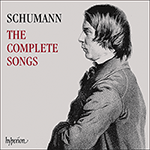
Welcome to Hyperion Records, an independent British classical label devoted to presenting high-quality recordings of music of all styles and from all periods from the twelfth century to the twenty-first.
Hyperion offers both CDs, and downloads in a number of formats. The site is also available in several languages.
Please use the dropdown buttons to set your preferred options, or use the checkbox to accept the defaults.

No matter, the poem is significant only in its lack of love-struck rapture. It seems that Schumann is no longer attempting to smuggle covert passionate messages to Agnes Carus; instead he is enjoying his life as a poor, but independent, musician. The composer, like the young shepherd, is content with his greatest possession: his gift for music. The songs of the young shepherd boy resound from mountain to mountain and down into the valleys – a theme which was to be developed only a few months later (October 1828) by Franz Schubert in his Der Hirt auf dem Felsen.
The ‘Hifthorn’ is a richly decorated medieval instrument (sometimes known as the ‘Oliphant’) made of ram’s horn or ivory, and capable of a limited number of notes in the lower register. Schumann’s instrument, the piano, though capable of many more notes, was also hand-finished in ivory. The limitations of the boy’s musical world are reflected in the simplicity of this folksonglike piece. Although it is far from easy to sing (music of this kind always poses the greatest technical challenges) it is less musically demanding than any of the other songs from this period. Can it be that Schumann has tired of writing songs for Agnes that were beyond her capabilities? This music may indeed have been far more suited to her than the ardent meanderings of the Kerner songs; and it would also have given her a ‘pants part’ – a highly fashionable concept in the age of Rossini. The direction is ‘Kindlich und innig’ (In the manner of a child and heartfelt). Both of these words are essential directions for understanding much of Schumann’s mature music. Indeed, this Hirtenknabe would not have been out of place in the Liederalbum für die Jugend Op 79 (1849) where it would have been a fitting companion for Des Knaben Berglied (‘Song of the mountain lad’) Op 79 No 9, and Des Sennen Abschied (‘The alpine herdsman’s farewell’) Op 79 No 23. In terms of mood and tonality (A minor) the song has also something in common with Die Waise Op 79 No 15. Its curious relationship to Schlusslied des Narren (track 13) is discussed in the next commentary.
This piece is the third of Schumann’s early songs to be re-cycled as a piano piece – in this case No 4 of the six Intermezzi Op 4 (1832-33). This music is marked Allegretto semplice, and 12/8 has replaced 3/8. The familiar A minor melody (in eloquent forte octaves) is introduced only after a prefatory fanfare of triplets, prancing and high spirited – a tiny overture where the curtain rises to reveal a horn-playing singer among cardboard mountains. In this music in particular we sense that the composer is quoting this melody as an affectionate reminiscence of times gone by. It is also the only occasion that he preserved the original key of a song in its piano transcription.
from notes by Graham Johnson © 2003
 Schumann: The Complete Songs Schumann: The Complete SongsSchumann’s songs are among the greatest musical achievements of the nineteeth century, and this is the perfect release with which to mark the composer’s 200th birthday. This marvellous collection comprises Schumann’s complete songs, presented for ...» More |

